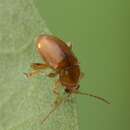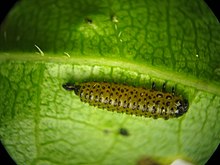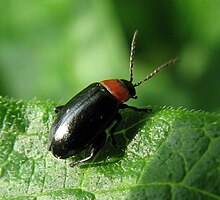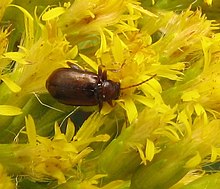en
names in breadcrumbs



The flea beetle is a small, jumping beetle of the leaf beetle family (Chrysomelidae), that makes up the tribe Alticini which is part of the subfamily Galerucinae. Historically the flea beetles were classified as their own subfamily.
Though most tribes of the Galerucinae are suspect of rampant paraphyly in the present delimitation, the Alticini seem to form a good clade.
Traditionally, the Alticini were separated from other Galerucinae by the presence of a metafemoral spring (i.e., jumping hind legs). Recent phylogenetic studies suggest that jumping hind legs evolved multiple times in the Galerucinae, rather than once, and that several genera should be transferred between Alticini and Galerucinae sensu stricto (or Galerucini in some classifications).[2][3]
The adults are very small to moderately sized Chrysomelidae (i.e. among beetles in general they are on the smallish side). They are similar to other leaf beetles, but characteristically have the hindleg femora greatly enlarged. These enlarged femora allow for the springing action of these insects when disturbed. Flea beetles can also walk normally and fly. Many flea beetles are attractively colored; dark, shiny and often metallic colors predominate.
Adult flea beetles feed externally on plants, eating the surface of the leaves, stems and petals. Under heavy feeding the small round holes caused by an individual flea beetle's feeding may coalesce into larger areas of damage. Some flea beetle larvae (e.g. of Phyllotreta species) are root feeders.
In adverse weather conditions (rain, for example) some flea beetles seek shelter in the soil. Some species, such as Phyllotreta cruciferae and P. striolata, prefer to leave their hideouts only during warm and dry weather. The German name Erdflöhe (literally "earth fleas") refers to their jumping ability and this behavior of hiding in the soil.
Flea beetles may be beneficial or may be pests, depending on the species.
Many major agricultural crops are attacked by flea beetles, including various cruciferous plants such as mustard and rapeseed (particularly canola in northwestern North America). Numerous garden plants are also subject to flea beetle feeding, such as flowers of Gardenia and Rothmannia by Altica species.
Flea beetles execute their most severe attacks during dry weather and are most active on sunny days. The larvae are known to chew roots.[4]
Flea beetles can be deterred by a number of different companion plants, that can be grown intercropped in a garden to benefit neighboring plants. For example, thyme, catnip, and other kinds of mint cover up the scent of nearby plants.[5]
Radishes, on the other hand, can be grown as a trap crop, luring the flea beetles away from more important crops. Since the root isn't harmed by the beetles, they remain useful, themselves.[6]
A number of natural predators can be employed to keep flea beetles in check, including two that parasitize it: braconid wasps and tachinid flies. In both cases, the larval stage feeds on the flea beetle, while the adults feed on nectar and pollen; some species are even important pollinators. To encourage braconid wasps and tachinid flies, some types of flowers can be planted between crops: umbels such as caraway, herb fennel, coriander and Ammi majus, and simple open flowers such as California poppies and pot marigolds, as well as yarrows.[7]
Other flea beetle species are beneficial, feeding on weeds and similar nuisance plants. A few species have even been introduced to various locations as biological control agents against some weeds. One important example is in the control of leafy spurge (Euphorbia virgata), an invasive weed in the United States. It has a toxic latex and is generally avoided by herbivores. Flea beetles of the genus Aphthona have been successfully introduced to control this plant.
This genus list is not complete. It is also partially from ITIS and might include genera placed elsewhere in other sources.
Argopistes coccinelliformis amid feeding damage on Osmanthus × fortunei
Altica lythri. Note thick hindleg femora
Eight-spotted flea beetle Omophoita cyanipennis
 Altica species larva
Altica species larva  Disonycha xanthomelas
Disonycha xanthomelas  Luperaltica nigripalpis
Luperaltica nigripalpis The flea beetle is a small, jumping beetle of the leaf beetle family (Chrysomelidae), that makes up the tribe Alticini which is part of the subfamily Galerucinae. Historically the flea beetles were classified as their own subfamily.
Though most tribes of the Galerucinae are suspect of rampant paraphyly in the present delimitation, the Alticini seem to form a good clade.
Traditionally, the Alticini were separated from other Galerucinae by the presence of a metafemoral spring (i.e., jumping hind legs). Recent phylogenetic studies suggest that jumping hind legs evolved multiple times in the Galerucinae, rather than once, and that several genera should be transferred between Alticini and Galerucinae sensu stricto (or Galerucini in some classifications).
Los alticinos (Alticini) son una tribu de coleópteros de la familia de los crisomélidos.
Los adultos son crisomélidos muy pequeños o de tamaño mediano. Son similares a otros escarabajos que habitan en las hojas, pero habitualmente tienen las patas traseras enormemente alargadas, cosa que les permite los súbitos saltos que hacen cuando se los perturba. Los alticinos también pueden moverse con normalidad y volar. Algunos tiene colores atractivos: oscuros, brillantes y a menudo predominan colores metálicos.
Los alticinos se alimentan en el exterior de las plantas, comiendo la superficie de las hojas, tallos y pétalos. Si la infestación de la planta es grande, los pequeños agujeros redondos que hacen al alimentarse pueden unirse en grandes zonas dañadas. Algunas larvas de alticino (por ejemplo, las especies del género Phyllotreta) se alimentan de las raíces.
En condiciones climáticas adversas (como por ejemplo, la lluvia) algunos alticinos buscan refugio en el suelo. Algunas especies, como Phyllotreta cruciferae y Phyllotreta striolata, prefieren abandonar sus escondites sólo en tiempo seco y cálido. El nombre alemán "Erdflöhe" (literalmente "pulgas de tierra") hace referencia a su capacidad para saltar y a la costumbre de esconderse en el suelo.
Los alticinos pueden ser beneficiosos o representar una plaga, dependiendo de la especie. Muchos de los principales cultivos agrícolas son atacados por los alticinos, incluyendo varias brasicáceas como la mostaza y la colza (principalmente la mostaza en el noroeste de América del Norte. Numerosas plantas de jardín son objeto de mira de los alticinos para alimentarse, tales como las flores Gardenia y Rothmannia son atacadas por especies del género Altica.
Otras especies de alticinos son beneficiosas, pues se alimentan de malezas y plantas molestas. En ciertas zonas se han introducido algunas especies para el control biológico contra las malezas. Un ejemplo importante es el control biológico de la euforbia (Euphorbia esula), una especie invasora proveniente de Europa. Cuenta con un látex tóxico y, en general, es evitada por los herbívoros. Los alticinos del género Aphthona han sido introducido a los Estados Unidos con éxito para el control de esta planta.
Los alticinos (Alticini) son una tribu de coleópteros de la familia de los crisomélidos.
Les altises, ou sous-famille des Alticinae, sont des insectes sauteurs de l'ordre des coléoptères et de la famille des chrysomélidés (souvent classés dans la sous-famille des Galerucinae en tant que tribu des Alticini). Ils sont ravageurs de nombreuses cultures. Ils ont les pattes arrière très développées et sautent lorsqu'ils sont dérangés. Leur nom, qui date du XVIIIe siècle, (h)altica, provient du grec haltikos, « habile à sauter ».
On reconnaît facilement les dommages que font les altises adultes par les feuilles criblées de petits trous plutôt ronds qu'elles laissent après leur passage. La plupart des espèces d'altises sont de couleur foncée et lustrée et atteignent de 2 à 5 mm de longueur. Les antennes mesurent de la moitié aux deux tiers de la longueur du corps selon les espèces.
Il est assez facile de s'en débarrasser, sans aucun produit chimique: Doucher avec un jet d'eau en pluie fine pour les faire fuir. Elles vont revenir au bout de quelques heures. Recommencer un arrosage des feuilles. Au bout de 4 ou 5 douches, lassées les altises ne reviennent pas.
Selon NCBI (29 août 2014)[1] :
Les altises, ou sous-famille des Alticinae, sont des insectes sauteurs de l'ordre des coléoptères et de la famille des chrysomélidés (souvent classés dans la sous-famille des Galerucinae en tant que tribu des Alticini). Ils sont ravageurs de nombreuses cultures. Ils ont les pattes arrière très développées et sautent lorsqu'ils sont dérangés. Leur nom, qui date du XVIIIe siècle, (h)altica, provient du grec haltikos, « habile à sauter ».
On reconnaît facilement les dommages que font les altises adultes par les feuilles criblées de petits trous plutôt ronds qu'elles laissent après leur passage. La plupart des espèces d'altises sont de couleur foncée et lustrée et atteignent de 2 à 5 mm de longueur. Les antennes mesurent de la moitié aux deux tiers de la longueur du corps selon les espèces.
De Alticini (aardvlooien of vlokevers) is een geslachtengroep van kevers uit de familie bladhaantjes (Chrysomelidae). Oorspronkelijk was ze taxonomisch ingedeeld als een onderfamilie (Alticinae), maar nu behoort ze zelf tot de onderfamilie Galerucinae.
Het zijn kleine tot zeer kleine kevers (meestal niet groter dan 5 mm), die grote sprongen kunnen maken als ze verstoord worden, dankzij een apart veermechanisme (de "metafemorale veer") in het sterk ontwikkeld bovenste lid van de achterste poten. De dekschilden hebben meestal een metaalglans en zijn bruin tot blauw-zwart.
Deze geslachtengroep telt ongeveer 500 geslachten en 4000 tot 8000 soorten. Ze komt over de hele wereld voor, maar vooral in de tropische gebieden van Zuid-Amerika, Afrika en Azië.[1]
De kevers zijn planteneters en voeden zich op de bladeren en stengels en zelden op de bloemen van welbepaalde planten. Naargelang de soort die ze verkiezen, kunnen ze schadelijk zijn (bijvoorbeeld kevers die zich voeden op groenten uit de kruisbloemenfamilie) of nuttig als ze zich voeden op onkruidgewassen.
Bronnen, noten en/of referentiesEm entomologia, o termo besouro-saltador é a designação comum a todos os insetos coleópteros da grande tribo Alticini, da família dos crisomelídeos, capazes de dar grandes saltos. O grupo já foi classificado como subfamília com o nome Alticinae.
Em entomologia, o termo besouro-saltador é a designação comum a todos os insetos coleópteros da grande tribo Alticini, da família dos crisomelídeos, capazes de dar grandes saltos. O grupo já foi classificado como subfamília com o nome Alticinae.
Земляные блошки[1][2], или блошаки[1] (лат. Alticini)— триба жуков из семейства листоедов, из подсемейства козявок (Galerucinae). Также может рассматриваться в виде подсемейства (Alticinae, Halticinae). Древнейшие представители трибы Alticini были найдены в балтийском и ровенском янтарях (эоцен)[3].
Обладают прыгательными задними ногами с утолщёнными бёдрами[4]. Имеют пунктирообразные усики. Размеры тела от 1 до 5 мм. Науке известно около 5000 видов. Ареал космополитный. На территории СНГ — около 400 видов. Земляные блохи — растительноядны. Развитие происходит в двух либо в трёх фазах. В более холодных частях ареала некоторые виды перезимовывают под растительными остатками либо в почве, за что и получили своё название. Земляные блохи откладывают яйца главным образом в почву либо в растение, либо на него. Там же растут и личинки. В сельском хозяйстве земляные блохи являются одним из основных вредителей.
Земляные блошки, или блошаки (лат. Alticini)— триба жуков из семейства листоедов, из подсемейства козявок (Galerucinae). Также может рассматриваться в виде подсемейства (Alticinae, Halticinae). Древнейшие представители трибы Alticini были найдены в балтийском и ровенском янтарях (эоцен).